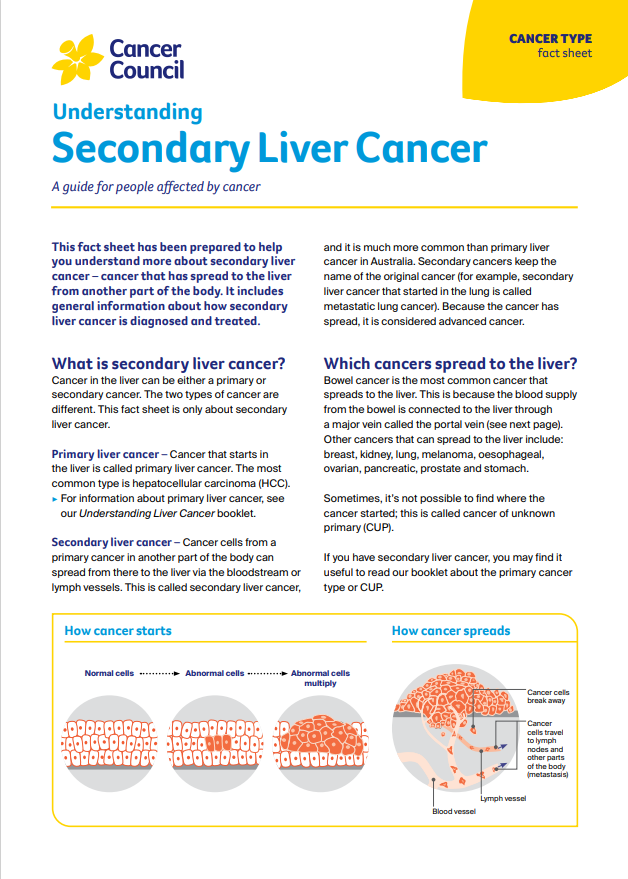Secondary liver cancer tests
Here we look at the diagnostic tests for secondary cancer in the liver.
Learn more about:
Blood tests
Blood tests alone cannot diagnose secondary liver cancer, but they can give doctors more information about the cancer.
Samples of your blood may be tested to check how well the liver is working (liver function tests) and to see if the liver is making proteins that help the blood clot.
Imaging scans
Various imaging scans may be needed when secondary liver cancer is suspected:
- You may first have an ultrasound scan, which helps to show if there is a tumour in the liver and how large it is.
- You will also have a CT (computed tomography) scan and/or an MRI (magnetic resonance imaging) scan. These types of scans can provide more detail about the size of the cancer and the number of tumours.
- A PET (positron emission tomography) scan can be combined with a CT scan to provide even more detail about the cancer. This is called a PET-CT scan. Medicare does not always cover the cost of PET–CT scans for cancer diagnosis; if this test is recommended, check with your doctor if you will have to pay.
Biopsy
Occasionally, a tissue sample may be removed from the tumour to confirm a diagnosis of secondary liver cancer. This test is called a biopsy.
Tests to find the primary cancer
If test results show that you have secondary liver cancer, the next step is to work out where in the body the cancer started. This may be known if you have been treated for cancer in the past; otherwise, you will need further tests.
Sometimes, even after several tests, the primary cancer can’t be found. This is called cancer of unknown primary (CUP).
Depending on where your doctor thinks the primary cancer started, you may have:
- an examination of the bowel (colonoscopy), stomach (endoscopy) or breasts (mammogram)
- a urine test to show whether the kidneys and bladder are working properly
- a blood test to check for particular chemicals produced by cancer cells. These are known as tumour markers and they relate to the primary cancer – for example, bowel cancer sometimes produces a tumour marker called carcinoembryonic antigen (CEA).
At first, I found the MRI frightening, going into the cylinder and having to hold my breath. But now when I have this scan, I count to myself. This helps me feel more in control.
Robyn
→ READ MORE: Secondary liver cancer staging and prognosis
Podcast: Tests and Cancer
Listen to more episodes of our podcast for people affected by cancer
More resources
Prof Desmond Yip, Senior Staff Specialist, Department of Medical Oncology, The Canberra Hospital, ACT (clinical update); A/Prof Siddhartha Baxi, Radiation Oncologist and Medical Director, GenesisCare, Gold Coast, QLD; Prof Katherine Clark, Clinical Director of Palliative Care, NSLHD Supportive and Palliative Care Network, Northern Sydney Cancer Centre, Royal North Shore Hospital, NSW; Anne Dowling, Hepatoma Clinical Nurse Consultant and Liver Transplant Coordinator, Austin Health, VIC; A/Prof Koroush Haghighi, Liver, Pancreas and Upper Gastrointestinal Surgeon, Prince of Wales and St Vincent’s Hospitals, NSW; Karen Hall, 13 11 20 Consultant, Cancer Council SA; Dr Brett Knowles, Hepato-Pancreato-Biliary and General Surgeon, Royal Melbourne Hospital, Peter MacCallum Cancer Centre and St Vincent’s Hospital, VIC; Lina Sharma, Consumer; A/Prof Simone Strasser, Head of Department and Hepatologist, AW Morrow Gastroenterology and Liver Centre, Royal Prince Alfred Hospital and The University of Sydney, NSW; David Thomas, Consumer.
View the Cancer Council NSW editorial policy.
View all publications or call 13 11 20 for free printed copies.

